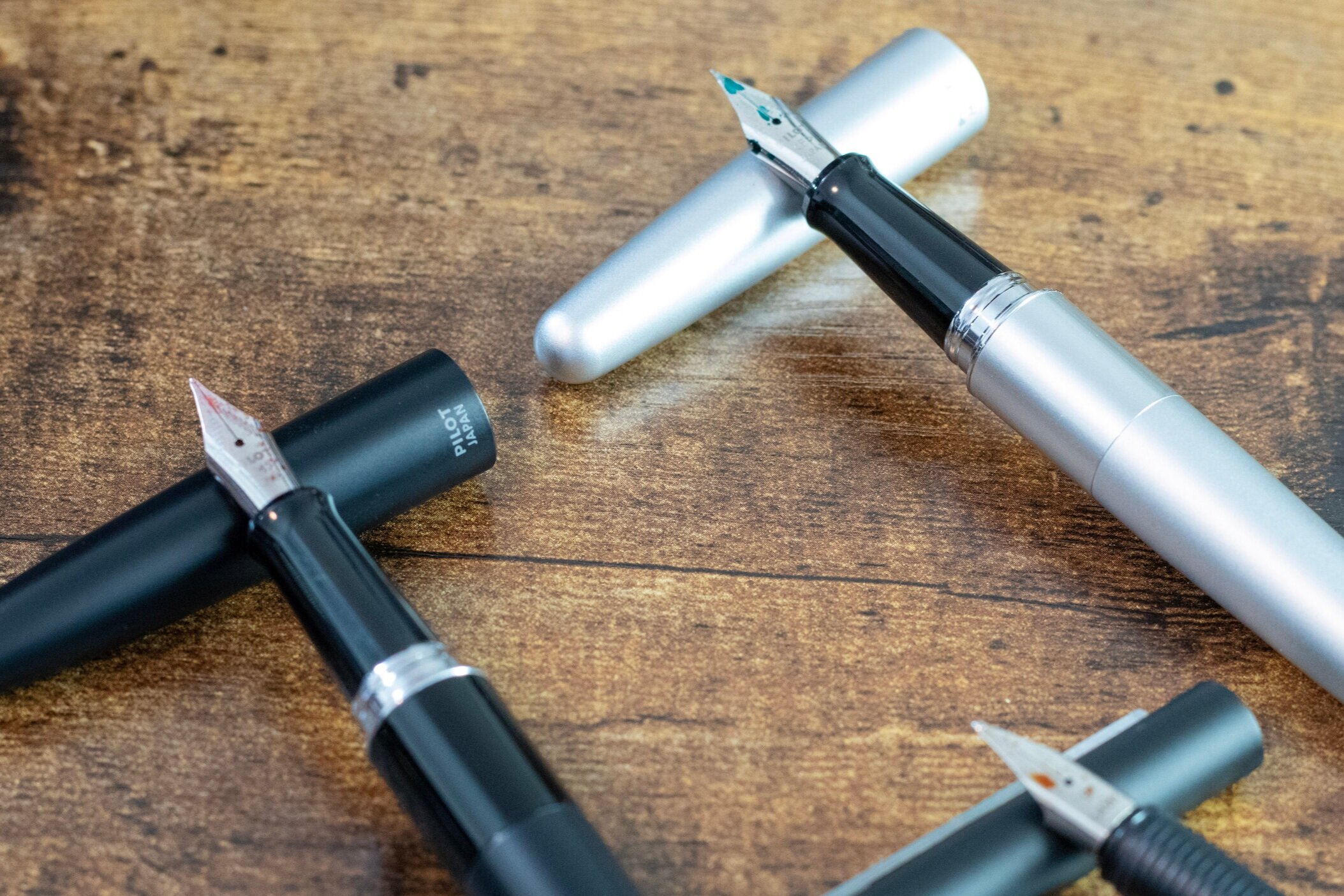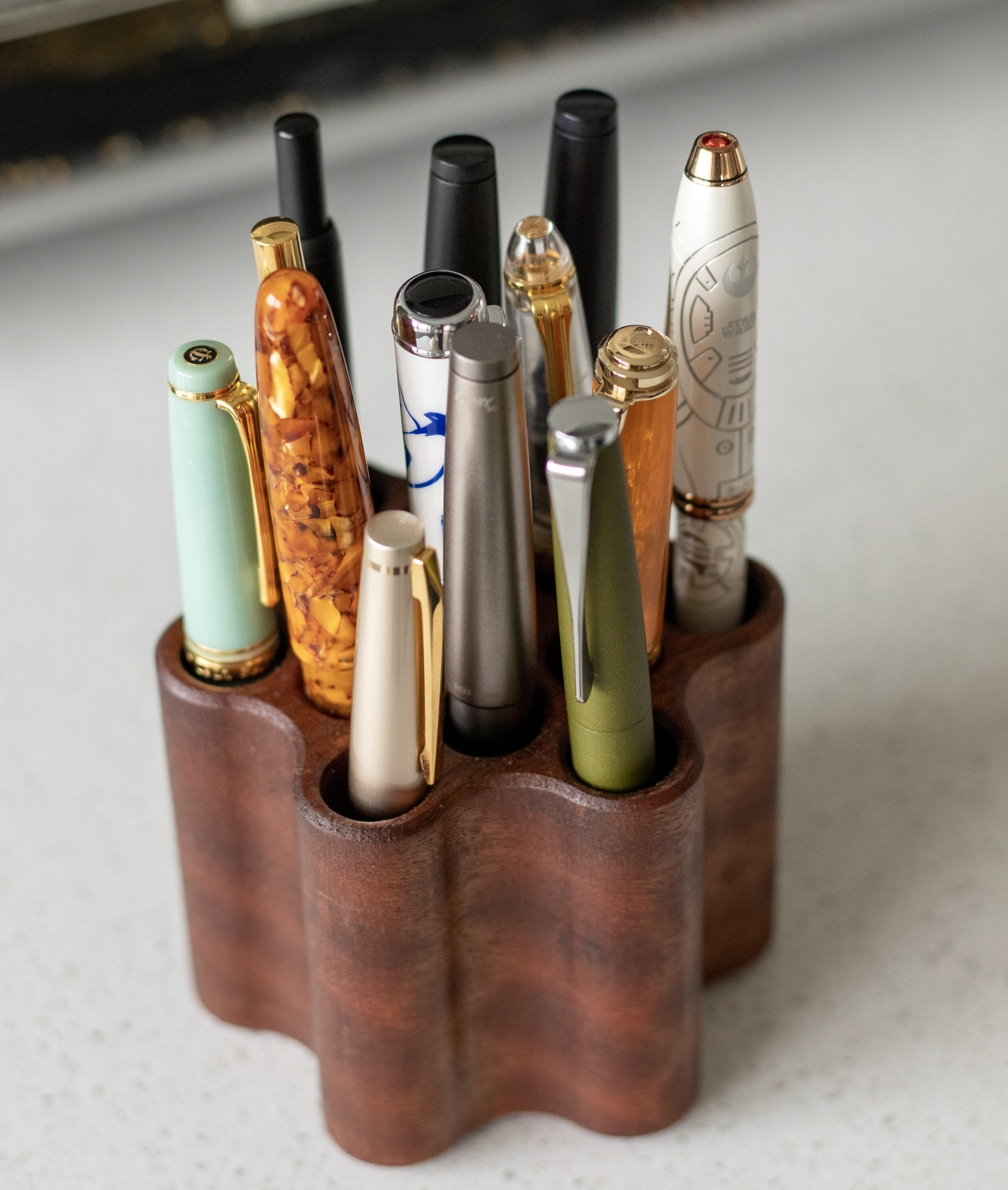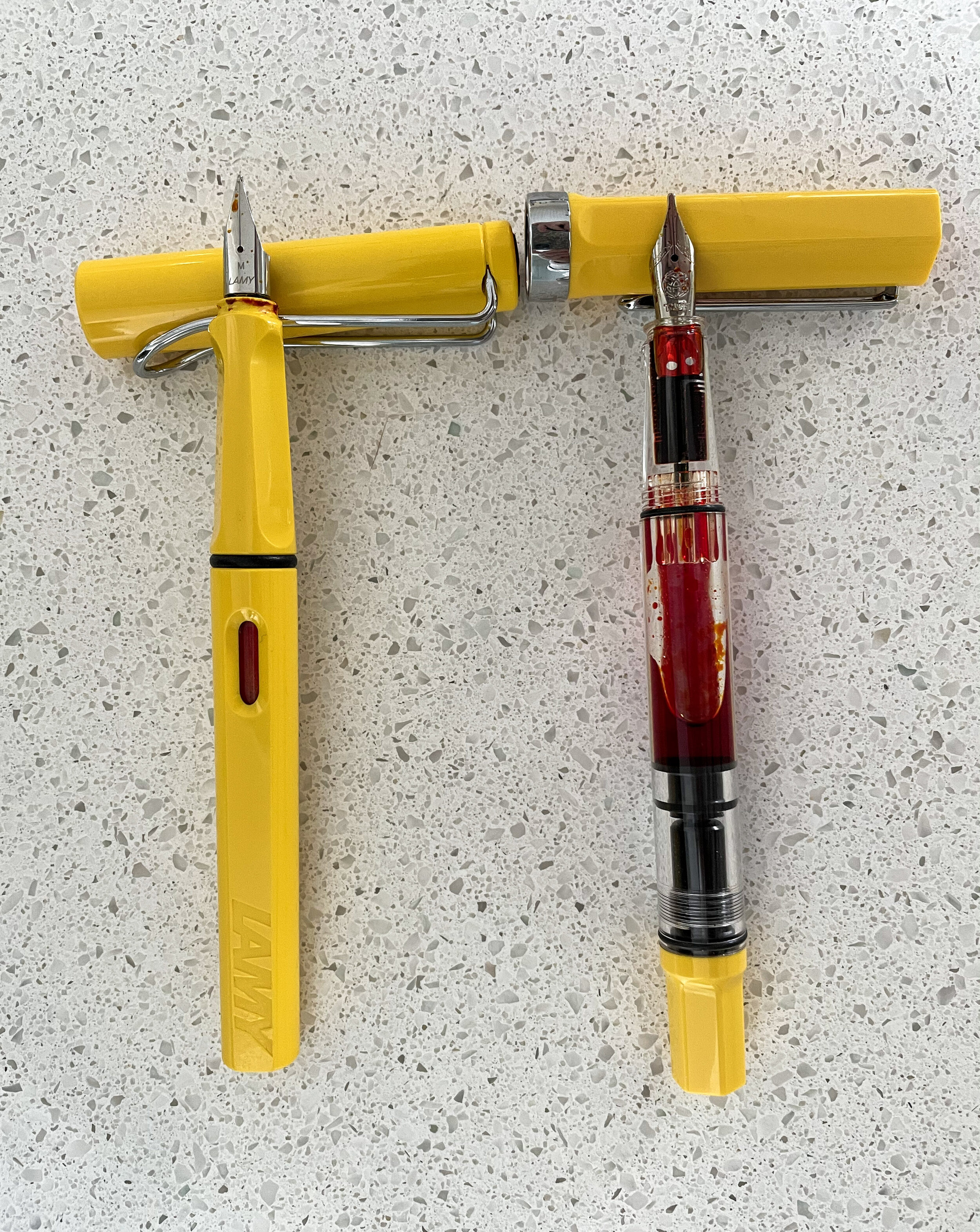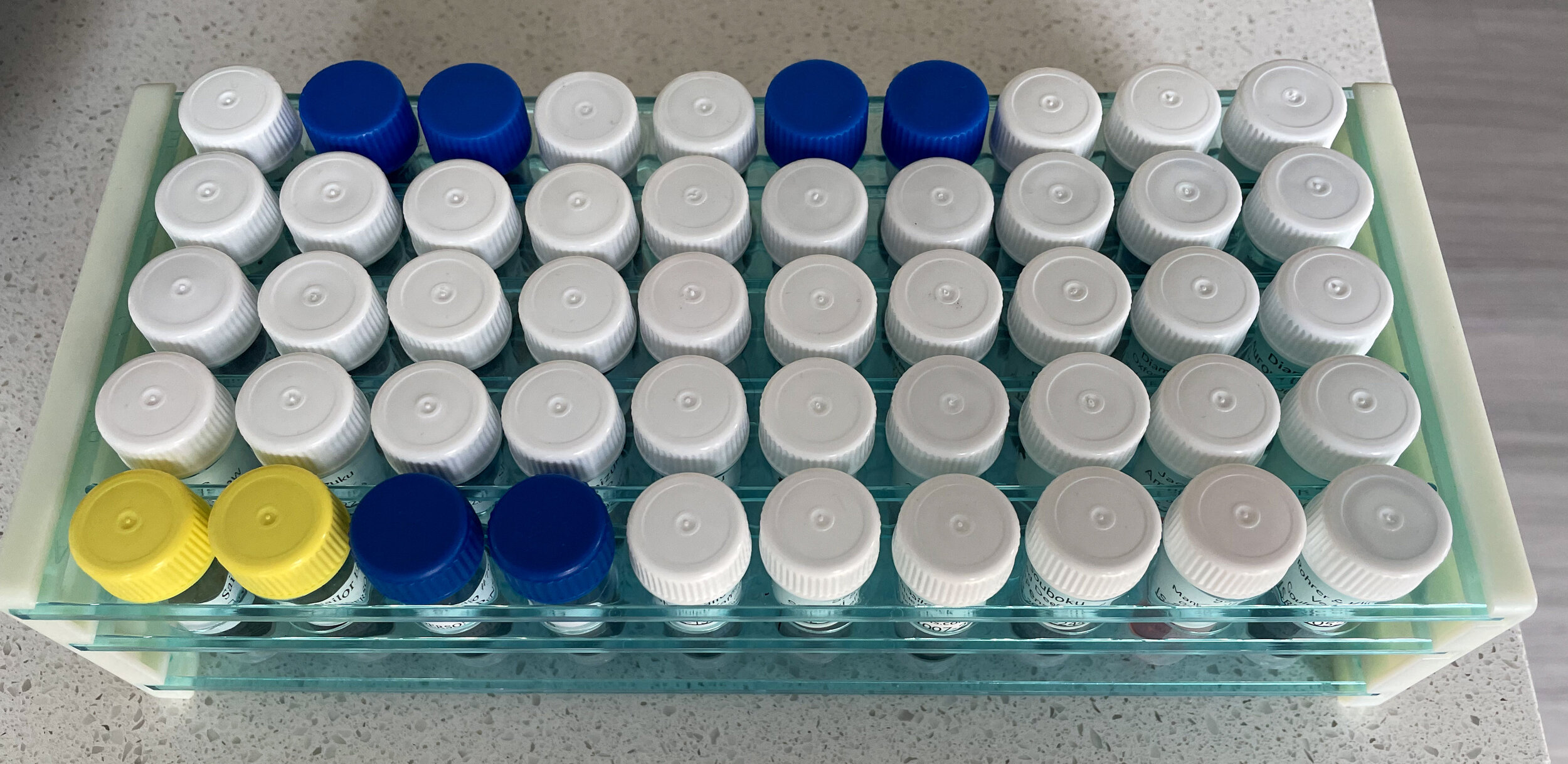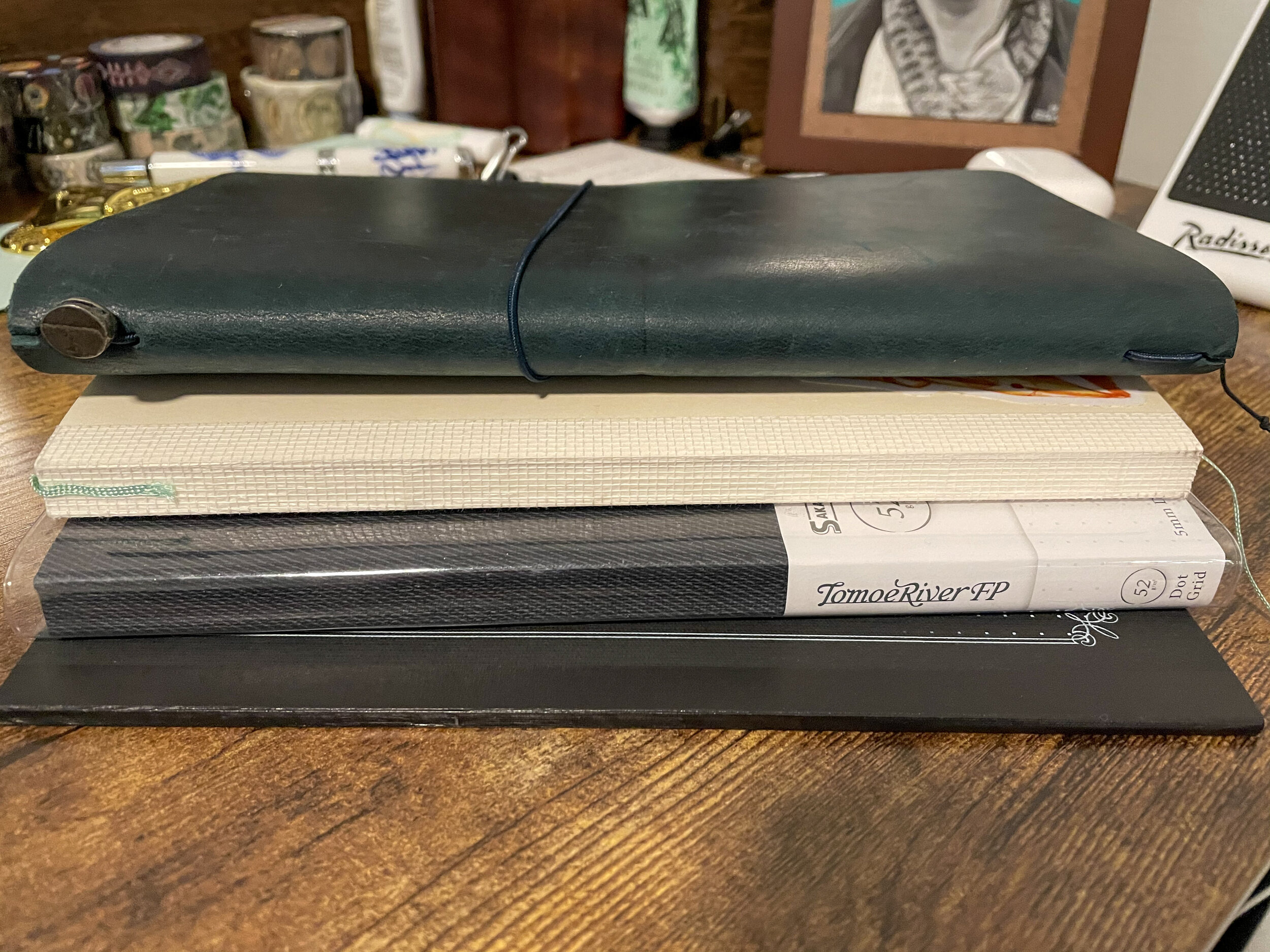A Beginner’s Guide to Fountain Pens
Left is a black Pilot Metropolitan (M nib) and Right is a Silver Pilot Metropolitan (F Nib)
The idea and execution of writing a beginner’s guide to fountain pens is certainly not revolutionary by any stretch of the imagination, and I am not in the business of reinventing the wheel.
However, I do know that I have some followers/readers who are just now venturing into the world of fountain pens and that figuring out where to start is a bit overwhelming, so I figured I’d do my best to give a brief overview (shaded by my own personal opinions). Being brief really isn’t the thing I’m known for, but I’ll do my best to keep my normally verbose nature at a minimum.
Before jumping into the “guide”, I do want to address a more specific query of “why fountain pens?”
In my first post, I gave a bit of insight into how I got started and where my propensity for writing instruments and stationery comes from. But the other day, I was asked what I use fountain pens for, and kind of just, why? And I realized that I didn’t really have a great answer ready. This bothered me, not because I felt the need to justify anything, but because I wanted something succinct that would make sense to others and that might also make them interested to know more.
Common assumptions about fountain pens are that they are antiquated or for calligraphy only (or a little of column A, a little column B). And until January of 2019, I also was not aware that new fountain pens are currently being made, redesigned, and evolving, both from large companies and small businesses.
So what is it about fountain pens? For me, it is a combination of their beauty, sustainability, and versatility. Succinct, right? But as this is a blog and you can’t stop me, I’m going to dive deeper into these reasons.
Versatility
I have always been the prodigious note-taker and have long purchased packs of pens that come in different colors so that I could make sure different things would stand out in my notes. When I was in grade school/high school it was the gel pens (shimmery, bright, pastels, you name it), when I was in college it was the Sharpie marker felt-tip pens (any different edition that they came in), and when I was working as an account manager it was the Sharpie liquid highlighters in different colors (for a bit of flair when going through contracts and proposals).
When I discovered fountain pens, it was like all of those^ things but on steroids.
There are SO. MANY. DIFFERENT. PENS. AND. INKS. I cannot overstate this - it is insane the different styles of pen bodies, pen materials, nib materials, nib styles, nib widths, ink colors, and ink properties. You can have so many different combinations and no two pens will ever be the exact same.
I am a tactile person, and the feel of writing with a fountain pen is completely different than that of any other writing instrument. Even amongst fountain pens, each pen feels so entirely distinct. It inspires me to write. I have written so much more, exponentially more, since getting into fountain pens, and I think it has really helped me mentally.
Beauty
Additionally, the pens themselves are often so beautiful that just looking at them is worth it. I truly could look at pens all day (and honestly… I really do sometimes). They are works of art and feats of engineering. In my opinion, they are the most beautiful tools that exist.
While a pen can be beautiful for many reasons, some pens and/or nibs stand out for being made with precious metals like solid gold, or have precious gems in them, or are painted using ancient and special techniques. Some are made from a unique or rare material. Being functional is key, but the fact that this intersects with cultural diversity in the best way possible makes each pen so exciting and educational.
Sustainability
Lastly, while many fountain pens are “mass produced” there are a lot less of them than plastic, disposable pens. They are meant to be owned for long periods of time and not disposed of, but handed down (or sold secondhand).
Now, I do not know any actual figures when it comes to their environmental impact, but I do know that I have had my pens for years now, plan to have them for many more years, and know many other fountain pen enthusiasts who keep their pens for decades.
I do not buy any other type of pen anymore, so while I do have a decent number of fountain pens, I know that I have gone through many less pens that I would if I was still buying Sharpie felt-tip markers, etc.
(Now for the actual guide…)
The Trifecta - Pens, Ink, Paper
In my opinion, the most important thing to realize when getting into fountain pens is that the pen you use, the ink you use in it, and the paper you use it on are all extremely important.
This may be controversial to some, as the truth is that you could get a simple fountain pen, with simple ink, and write on “normal” paper (i.e. your average copy paper/random notebook/journal) and this would work. I’m glad of this truth because it means that the barrier to entry is quite low.
However, because there is an almost endless combination of pens, nibs, ink, and paper out there, you may try a combination when you first start that doesn’t “speak to you.” Or potentially, you might get a faulty nib or bad ink.
So, initially I want to say to you that it both does, and doesn’t, matter what you use to start. From experience, I can tell you that the first fountain pen and ink I ever tried, I did enjoy, but not nearly as much as the combinations I now use after much trial and error.
I also know from reading many accounts of other first-timers that many people disliked their initial foray into fountain pens, decided against using them, only to pick up a different pen years later and find that they actually do enjoy fountain pens and are hooked.
So, while I enjoy using a fountain pen in general, there are certain combinations of the “trifecta” that bring me much, much more joy than others, making it a priority for me to use specific pens, inks, and paper.
Subjectivity - A Disclaimer
Before we break down some further beginner information on each part of the trifecta, I want to shout this:
Almost all information you read comparing fountain pens, inks, and paper is subjective.
There are definitely some qualifications that can make something “better than” something else, but you’d have to first agree on the parameters and then define within that what makes X better than Y. As I’ve mentioned, the sheer amount of choices in these categories make this a large, overwhelming, and arguably impossible task.
So, instead of strict objectively graded facts, we’ll be dealing with the mostly-subjective-but-commonly-agreed-upon opinions for this guide.
Fountain Pens
Under my “Resources” tab, you’ll find many links to helpful sites, graphs, glossaries, and breakdowns when it comes to pens, ink, and paper. I’ll be linking some of them here, but it’s also a great spot to check out some more in-depth information if you have more questions or want to learn more.
What is a fountain pen? From nibs.com:
Origins Of The Fountain Pen
A fountain pen is a writing instrument equipped with a metal nib (usually solid gold) that utilizes a cartridge, converter, or other internal reservoir in order to provide a continuous and refillable ink supply. Fountain pens were introduced in the late 19th century and largely replaced the earlier dip pen, which had evolved from feather pens and which required dipping in an ink well every few lines in order to maintain an ink supply.
First - Anatomy of a Fountain Pen
If you know absolutely nothing about fountain pens, click here. This is a helpful guide from The Goulet Pen Company that breaks down the anatomy of a fountain pen and will familiarize you with the typical components that make up a fountain pen and what they do.
Second - Fountain Pen 101
Once you have a basic understanding of the fountain pen, click here. It is again from The Goulet Pen Company, includes a TON of helpful videos/blogs, and from their site is described as such:
When you're first starting out with fountain pens, it can be confusing trying to understand how they work and what you need to know to get started. We set up this Fountain Pen 101 series to make it easier to learn the basics of fountain pen use so that you spend less time struggling and more time having fun!
Third - Nibs
The links provided will give more technical and detailed information on nibs, but here are a few general things to keep in mind when first starting out:
Tip Size- the tip is the writing end of the pen, and just like you can buy different sizes of rollerballs or gel pens, fountain pen nibs come in a multitude of different sizes. This controls how wide the line is that you’re laying down on the page. The smaller the tipping size, the thinner the line. A thinner line is good for tinier writing or for paper that tends to “bleed" (seeing the ink through the paper on the other side) or “feather” (makes the lines look fuzzy). The larger the tipping size, the broader the line. Broad lines are great for showing off ink property/colors better, but it does mean you’re putting out a lot more ink than with a smaller tipping size and as such, these can be more prone to bleeding through paper or feathering.
Typical tip sizes, from smallest to largest: extra fine, fine, medium, broad, stub, italic, oblique.
Pen Chalet has a phenomenal nib breakdown guide with explanations
Nib Material - usually the two most common materials used for making nibs are steel and gold. If gold, it will usually be either 14k, 18k or 21k. The material does make a difference in the feel of the writing experience, but it also really just depends on the manufacturer and what they are known for.
You’ll hear descriptors like “springy”, “flexible”, “hard”, “nail”, “soft”, “buttery smooth", “feedback” and more, when describing the feel of the nib. None are objectively better than others, it’s based on preference and what you’re using it for. These descriptors might not make sense unless you’ve tried a variety of pens to really “get” what they mean.
For example, I like both the Sailor pen company, who is known for “hard, nail-like” nibs that provide an almost “pencil-like feedback”, as well as the Lamy 2000 nibs that are described as “buttery smooth”, provide almost no “feedback” and glide across the page.
Japanese vs. Western - You’ll hear this thrown around a lot when describing nibs. Essentially, nib/pens manufactured in Japan will have tips that run a size or two smaller than nibs produced in any Western countries (like…any other country). So, if you have a pen with a nib produced in Japan labeled as a Fine nib, and another pen with a nib produced in, say, Germany, labeled as a Fine nib, they will NOT write the same - not only in feel, but in line width.
Fourth - Filling System
This is covered in the list of videos from The Goulet Pen Company that I linked to under “Fountain Pen 101” but I do think it deserves it’s own little section so that you’re aware that you might buy a pen that fills completely differently than one you already tried.
Here’s the specific video from Goulet breaking down the typical different types and how they work. This should answer most questions you have when looking at different pens.
Fifth - Pen Material
I’m not going to get into this much other than to mention that the material the pen is made out of will GREATLY change the way it feels in your hand. If it’s made of metal, the pen will be heavier than a pen made from acrylic or resin.
The first pen I tried was a Pilot Metropolitan (metal bodied), followed by a Cross Townsend (metal bodied). Then I tried a pen with a resin body and I was SHOCKED at the difference. I honestly thought it felt cheap because it was so lightweight. But now that I know more about pens and have tried a lot, I like both materials and I know to expect the difference in weight.
Note - this information is not nearly exhaustive, but meant to help demonstrate how different your experience can be from pen to pen.
Beginner Pen Recommendations
Personally, I would recommend trying the Pilot Metropolitan with a Medium nib as your very first Fountain Pen.
I say this because of a few reasons:
Their quality control (or “QC”) is on point; meaning that you’ll get a nib that works great and is smooth right out of the box.
A Japanese medium nib is a great middle-ground for finding out if you like thinner or broader line widths.
The body is metal, so it feels a bit more “fancy” or “high quality” in the hand.
It fills via a convertor or cartridge. For very first time users, it’s a “plug’n’play” - you can stick a cartridge in there and get started without learning how to use a convertor or fill a piston filler, and when you’re ready to upgrade, the convertor is just as easy to stick in.
It is pretty accessible - you can get it from Amazon or almost any pen website online, and sometimes even find it a Meijer, Target, Staples, or other major retailers in store. I also recommend checking art stores and, if you live by a university, checking their “student supplies” stores.
However, as this is subjective, a couple other typically recommended beginner pens are the Lamy Safari (top) and the TWSBI Eco (bottom). Personally, I don’t care much for the Lamy Safari’s design and the nib quality control can be questionable. The TWSBI is visually more appealing to me, but the piston filler isn’t my favorite (I like to change out inks a lot), and the nibs don’t feel as smooth to me. BUT they are a great value and many people absolutely LOVE both of these pens.
Here are some other pen recommendation guides that I strongly recommend you look at to make an informed decision:
The Gentleman Stationer is a blog that I have enjoyed following to help inform my pen purchases and knowledge base. He has put together a “Best Pen” tiered list for the last 3-4 years and they are extremely helpful:
2020 Edition (includes links to other editions)
But I’m linking the 2018 Edition as well because that’s the last one that included the Pilot Metropolitan (clearly we disagree on this, haha)
Reviewgeek’s 14 Excellent Fountain Pens for Beginners and Experts
Ink
Fountain pen ink is so diverse and there are so many different types (scented, shading, sheening, shimmering, water-resistant, iron gall, the list goes on), different brands, different colors, and different properties that I quake at the thought of giving a “brief” overview (and let’s face it, I have done an absolutely terrible job of being brief already. Although, if you know how much information is out there, maybe comparatively I’ve done ok…).
Not all inks are safe for fountain pens.
You should not use an ink in your fountain pen that is NOT specifically designated for fountain pen use.
Even then, there are still fountain pen inks that can be questionable in your pen - like inks with glitter in it. I am not going to get into that because I’m not an expert, but I would recommend reading about fountain pen ink and your specific pen if you’re worried about hurting anything.
I will say that a commonly held safe brand for all pens is the Pilot Iroshizuku line (tsuki-yo shown above). Because of that and its diverse color choices, it’s one that I recommend to beginners.
That said, my favorite ink resource is Mountain of Ink.com. This site offers ways to look up and read about fountain pen ink in every way imaginable - by color, by brand, by property. I believe it is one of the best resources out there to make educated decisions on ink choices.
The biggest takeaways for ink are:
The same fountain pen ink in “Pen A with X nib” can look and feel COMPLETELY different in “Pen B with Y nib” (or even Pen A with Y nib). Truly, I have used an ink in one pen and hated it, and then tried it in another pen or nib size, and absolutely loved it. It can also affect your opinion on the pen and its performance.
Try ink samples first. Many sites sell samples (Goulet, Anderson pens, Pen Chalet to name a few) - 2-3ml little buddies so that you can decide how you feel about the ink first before spending $$ on a whole bottle.
Read reviews of inks and their properties so you have an idea of what you’re getting and how it might work with your pens.
My collection of ink samples
Paper
I do not have that many resources that go in depth on the different types of paper and its interaction/effect with fountain pens.
The basics of it are this - fountain pen-friendly paper is important in getting the “best” performance from your pen/ink combo. A lot of “regular” paper these days is optimized for the more common use of gel pens or ballpoint pens. These pens and their ink function very differently on paper than fountain pens and inks. Therefore, to get an optimal experience, it is recommended to use paper that is either designed for or friendly to fountain pens/inks.
The fun thing is that not all fountain pen-friendly paper is created equal, or even similarly.
Typically recommended paper/brands for use with fountain pens (the underlined ones are my favorite):
Tomoe River - probably the number one recommended, either 52gsm or 68 gsm. You can buy this in single sheets or in many different kinds of notebooks.
Clairefontaine
Maruman Mnemonsyne
Leuchtturm1917
Field Notes
Rhodia
Midori
Traveler’s Company
Here is a link to The Goulet Pen Company’s youtube video discussing Paper Quality Tiers
Which paper is the best for fountain pens? This episode of Write Now explores the different paper tiers we've established and the benefits of each as well as the drawbacks. See how some of our most popular inks perform across a number of paper examples, including Jacques Herbin Emerald of Chivor!
Jet Pens offers a write up for “The Best Fountain Pen Paper”
The Gentleman Stationer offers his take on the “best paper for everyday writing” in five parts
Mountain of Ink gives their ink reviews by showing how the ink behaves on different types of paper, which I think is a great way to kind of see what I mean by the way that the paper interacts with the pen/ink.
The Bottom Line
I would say it’s accurate to state that this blog entry is only the “tip of the iceberg.” As far as I know, there is no single exhaustive resource with information on either fountain pens, inks, or paper (and definitely not all three combined), so do some google searches, click through other parts of the websites I’ve linked here, join fountain pen groups on reddit or facebook or instagram, and just keep learning. That’s what I do! Read, read, and read.
TRY SO MANY DIFFERENT THINGS. I cannot impress upon you enough to try different pens, different nib sizes, different inks, different papers, different combinations of all of these things. I’ve tried so many things over the last two years and I still find new things, new combos that delight me.
Take your time! This is advice for you as much as it is for me. I am an impulsive and compulsive person and because of that, I tend to get a little nuts when I find things I like. This has led to a quick, and likely unwise, attainment of many pens and inks over a short period of time. From reading others’ accounts, it seems this isn’t unique, but as we’re in unprecedented times with questionable financial situations, just take your time trying new things - there’s no rush!
In conjunction with this, I HIGHLY recommend buying pens secondhand. I often frequent and buy pens from Reddit, on r/pen_swap. It’s a great way to get really cheap beginner pens (like getting three for the price of one, or sometimes free!) so you can try different things affordably.
A Note on Tolkien
Continuing the theme of this blog, I thought I’d just make a little note regarding Tolkien and fountain pens. Unfortunately for a die-hard fan like me who absolutely would attempt to get and use the same pen as Tolkien, it is generally understood that he did not typically use fountain pens. If he did, it is unknown which one, so there is no “favorite.”
He was known to use dip pens pretty often, which were precursors to fountain pens, and it seems that he often used them with an italic nib (which makes sense if you’ve seen examples of his writing).
In fact, there is an exhibit dedicated to him at the Marion E. Wade Museum which showcases a dip pen that he used (as well as the desk he wrote The Hobbit and Lord of the Rings on!).
Though Tolkien didn’t exhibit a particular fondness for fountain pens, Montegrappa, an Italian pen company known for “themed” pens, did pay homage to the Lord of the Rings by creating this absolutely stunning work of art. It is certainly not in my budget, but if it ever is…you best bet that I’ll be ordering it (the sterling silver version because I’ll never reach the solid gold $$$ O_O).
I would say “well, that’s all folks” but I think we learned that what is accounted for here is really NOT all and my exercise in brevity ended either miserably or I barely scratched the surface…
Thanks for reading, as always!

